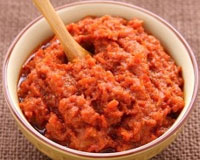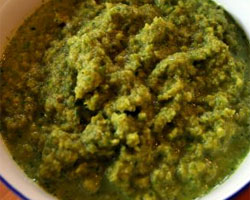Types of Curry Paste used in Asian Cuisines
A wide range of commercial curry pastes is
available from supermarkets and Asian stores and many of them are of
excellent quality. Fresh spice pastes can be time-consuming to prepare
so these ready-made products are great for making delicious, authentic
curries when you're in a hurry.
 Indian Curry Pastes Indian Curry Pastes
Spice pastes tend to have a more authentic
flavor than curry powders, which often include a dry-tasting imbalance
of spices that produces a slightly stale flavor. A typical recipe for a
paste might include cilantro and cumin seeds, tamarind, peppercorns,
cardamom, ginger, chili powder, cloves and nutmeg, all finely ground and
mixed with oil. Other spices that might be added are mustard and fennel
seeds, ajowan and cinnamon. Like curry powders, pastes are available as
mild, medium and hot.
If you are using commercial curry pastes,
you can give them an extra lift and a personal touch by adding fresh
herbs such as chopped cilantro and a squeeze of lime or lemon juice.
 Thai Curry Paste Thai Curry Paste
There are a number of different types of
Thai curry pastes, but the most common ones are red and green. Thai
spice pastes tend to be very hot and aromatic, as they are based on
fresh chilies and contain a variety of other spices and fresh herbs.
They can be used to make all kinds of curries with meat, poultry, fish,
shellfish and vegetables.
Traditional Thai spice pastes require
lengthy pounding and grinding. However, there are several good
commercial brands available, which take the effort out of cooking Thai
food. Recipes vary, but green curry paste usually contains cilantro and
cumin seeds, lemon grass, galangal or fresh root ginger, garlic, onion,
shrimp paste, fresh cilantro, salt, sugar and oil as well as green
chilies. It may also include other herbs and spices, such as mint,
caraway and nutmeg.
Red chili paste often consists of onions,
garlic, galangal or fresh root ginger, lemon grass, kaffir lime leaves,
cilantro roots, peppercorns, ground turmeric, cinnamon, coriander and
cumin seeds, shrimp paste, salt and oil, as well as plenty of fresh red
chilies.
The degree of heat depends on the variety of
chili used - Thai birds-eye chilies are extremely hot and fiery but, if
you prefer a slightly milder taste, you can use a less intense variety.
 Japanese Curry Roux Japanese Curry Roux
Japan was first introduced to curry in the
middle of the nineteenth century, not directly from India but via
England, where curry powder was concocted and exported.
Since then,
curry has become one of the most popular daily foods in Japan. The
Japanese further developed the powder into an instant curry sauce roux,
mixing together all the necessary ingredients such as herbs and spices,
fruits, soup stock, sauces and seasonings. It comes in the form of a
soft slab, resembling a chocolate bar, in a sectioned plastic tray.
All you need to do is boil the fresh
ingredients such as meat or shellfish, potato, onion and carrot, and add
some of these sauce mix. There are degrees of hotness: mild, medium, hot
and very hot. There are also separate roux for meat and fish. An average
packet normally serves 12, but remember that a Japanese portion is very
small and it really makes enough for only six to eight adult appetites,
particularly if eaten on its own.

Happy Cooking,
Carol |

